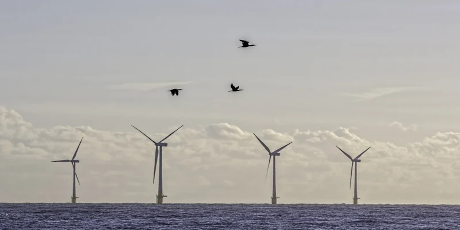How do we protect our native seabirds while growing offshore wind energy? 13 Feb 2024

Analysis: Ireland needs to rapidly expand its renewable energy production, impacting iconic species such as our globally important seabird populations - Emma Murphy, PhD Student, School of Biological, Earth and Environmetnal Sciences/ERI/UCC
Ireland's ambitious targets of achieving a climate resilient, biodiversity rich and carbon neutral economy by 2050 are heavily reliant on their goal of increasing the proportion of renewable electricity production to 80% by 2030. With an island so rich in wind resources from the Atlantic, the opportunity to harness this energy can play an integral role in achieving renewable energy and climate goals. On our current trajectory we are far from reaching our targets, now sitting 43rd out of 63 countries for our efforts in climate protection, as announced at COP28.
This means that Ireland is currently not adequately implementing climate protection policies compared to the commitments made by other countries identified as the primary producers of global greenhouse gas emissions. Ireland therefore needs to rapidly expand its renewable energy production. But what will this mean for our landscapes and iconic species such as our globally important seabird populations?
Seabirds are declining globally, with human activity a major factor. Atlantic puffin, an emblematic seabird species here in Ireland, has declined by 28% in Ireland since the last national census (1998-2002) making it a red-listed bird of conservation concern, and thus is vulnerable to extinction. Under National and European legislation, Ireland has a requirement to conserve these protected species, however introducing renewable wind energy infrastructure into the marine environment could have further negative impacts on populations, requiring careful planning to ensure developments are progressed with minimal impacts on biodiversity.
One of the main risks to seabirds from offshore wind farms (OWFs) is collision with turbines, resulting in death. However, some seabirds may respond to this risk by avoiding wind farm areas altogether, potentially requiring them to move to new, less favourable feeding areas. The first phase for proposed OWF development will promote the installation of fixed-bottom turbines. For this, sandy, shallower, and more accessible waters are preferred for development, which overlap with important, food-rich foraging areas for seabirds. Wind farms can however also benefit the surrounding environment by creating artificial reefs, thus potentially increasing the abundance of fish that seabirds depend on in the wider area over time.
Species such as gulls can be attracted to wind farms as they may boast a greater abundance of prey and provide the birds with platforms to roost on. This however poses a greater risk of colliding with the turbine blades, depending on the height the bird flies at. Displacement is a risk for species such as auks, including the Atlantic puffin. This species is both a less efficient flyer and is deterred by the presence of turbines, meaning they must expend more energy avoiding wind farms placed either within or along the route to important foraging areas. This will reduce their foraging efficiency and provisioning of their chicks, impacting the likelihood of their survival.
It is clear that seabirds will react in different ways to offshore wind farms, depending on factors such as how they find food and how long they can spend away from their nest either flying or resting on the sea surface. However, much of the existing knowledge is based on research conducted in other regions such as the North Sea. This may not accurately reflect what seabirds do in our own waters, and there is currently little information from most Irish seabird colonies.
All wind energy industry developers are legally required to assess potential environmental impacts of their development and must incorporate conservation and mitigation measures to counteract these. An important component of this is collection of 'baseline’ data to understand the current at-sea distribution, foraging hotspots, and flight heights across a range of species. Ireland’s seabird colonies are currently understudied, which limits our ability to predict the overall effects of OWF development on populations.
Read more: Can Ireland lead the offshore renewable energy race?
Ongoing research at UCC focuses on a range of the internationally important breeding seabirds here on our islands and coastlines, including gannets, terns, storm petrels and puffins. Miniature trackers are used to record information on the movement, flight height, flight speed, and diving behaviour of these birds to help identify preferred foraging areas and the routes taken, as well as the possibility to investigate associations with human activity such as fisheries. These studies have shown that our seabirds are capable of quite long foraging trips, likely requiring a lot of energy in flight. Aerial surveys of the entire national waters have also identified the wider distribution of seabirds in Irish waters, as well as hotspots of occurrence that suggest important habitats for seabirds best avoided by developments. These surveys have highlighted the Irish Sea and the south coast of Ireland as of particular importance for a range of breeding seabirds in Ireland, emphasising our need for implementing mitigative measures in the development process.
Ensuring that we progress development of renewable energy in a way that addresses climate change while also protecting vulnerable species still presents many challenges resulting from gaps in our current knowledge. This process is complex, requiring a range of complementary studies to both identify the risks to populations and to develop effective mitigation so that offshore wind farm development can progress at a pace required to meet our ambitious targets.